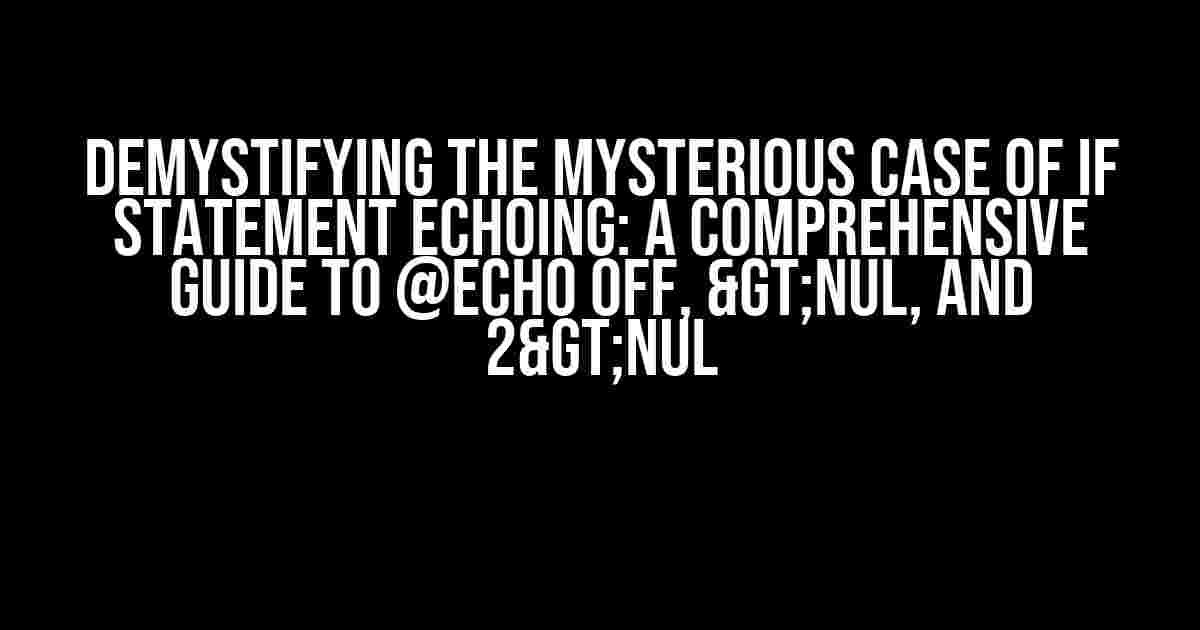The Basics: Understanding @echo off and Redirection Operators
@echo off: The Silent Treatment
The @echo off command is used to suppress the echoing of commands in the command prompt. When you prefix a command with the @ symbol, it tells the command interpreter to not display the command itself, only the output. This is particularly useful when you want to hide sensitive information or create a more streamlined output.
@echo off
echo Hello, world!In the above example, only “Hello, world!” would be displayed in the command prompt, without the actual echo command.
Redirection Operators: The Power of >nul and 2>nul
Redirection operators are used to redirect the output of a command to a file or another output stream. The > symbol redirects the standard output (stdout) to a file, while the 2> symbol redirects the standard error (stderr) to a file. When combined with the nul device, these operators can help suppress unwanted output.
echo Hello, world! >nul
echo This will generate an error 2>nulIn the above example, the first command redirects the output of the echo command to the nul device, effectively suppressing it. The second command redirects the error output (stderr) to the nul device, silencing any error messages.
The Problem: If Statement Echoing Despite @echo off and Redirection Operators
@echo off
if exist somefile.txt (
echo The file exists
) else (
echo The file does not exist
) >nul 2>nulThe Culprit: The parentheses
@echo off
if exist somefile.txt (
@echo off
echo The file exists
) else (
@echo off
echo The file does not exist
) >nul 2>nulThe Solution: Using Enabledelayedexpansion and Set /p
Enabledelayedexpansion: The Game-Changer
@echo off
setlocal enabledelayedexpansion
if exist somefile.txt (
set "output=The file exists"
) else (
set "output=The file does not exist"
)
set /p "="%output%" >nul 2>nulSet /p: The Output Silencer
@echo off
setlocal enabledelayedexpansion
if exist somefile.txt (
set "output=The file exists"
) else (
set "output=The file does not exist"
)
set /p "="%output%" >nul 2>nulConclusion: Mastering the Art of Silencing If Statements
| Command | Description |
|---|---|
| @echo off | Suppresses the echoing of commands in the command prompt |
| >nul | Redirects standard output (stdout) to the nul device, suppressing output |
| 2>nul | Redirects standard error (stderr) to the nul device, suppressing error output |
| enabledelayedexpansion | Allows delayed environment variable expansion within a block of code |
| set /p | Outputs the value of a variable, followed by a newline character, and can be used to silence output |
Frequently Asked Questions
-
Why does the if statement still echo out despite using @echo off?
- The parentheses used in the if statement enable the echoing of commands within the block, even when @echo off is used.
-
What is the purpose of enabledelayedexpansion?
- Enabledelayedexpansion allows delayed environment variable expansion within a block of code, enabling the manipulation of variables within the if statement.
-
How does set /p silences output?
- The set /p command outputs the value of a variable, followed by a newline character, and can be used to silence output when combined with the >nul 2>nul redirection operators.
Frequently Asked Question
If you’re wondering why your batch script is echoing out even with @echo off and redirection to nul, you’re not alone! Here are some frequently asked questions about this common issue:
Why is my batch script echoing out even with @echo off?
When you use @echo off, it only turns off the command echoing, not the output of the command itself. If your command generates output, it will still be displayed on the screen. For example, if you have a command like `dir >nul`, the `dir` command will still output the directory listing, even though you’ve redirected the output to nul.
What does >nul and 2>nul do in a batch script?
In a batch script, `>nul` redirects the standard output (STDOUT) to nul, effectively suppressing the output of the command. `2>nul` redirects the standard error (STDERR) to nul, suppressing any error messages. Using both `>nul 2>nul` redirects both STDOUT and STDERR to nul, ensuring that the command’s output is completely silent.
Why do I still see output when I use @echo off and >nul?
Even with `@echo off` and `>nul`, you might still see output if the command is generating output on STDERR instead of STDOUT. For example, if you have a command like `copy file1.txt file2.txt >nul`, and the file doesn’t exist, the error message will be displayed on STDERR, which isn’t redirected to nul. To suppress error messages as well, use `2>nul` or `>nul 2>nul`.
How do I completely silence a command in a batch script?
To completely silence a command, use both `@echo off` and `>nul 2>nul`. This will turn off the command echoing and redirect both STDOUT and STDERR to nul, ensuring that no output is displayed on the screen.
Are there any other ways to silence a command in a batch script?
Yes, you can also use the `> CON` or `>> CON` redirection operator to silence a command. This redirects the output to the console, which is essentially the same as redirecting to nul. Alternatively, you can use an external utility like `nul` or `/dev/null` (on Unix-like systems) to redirect the output to a null device.

